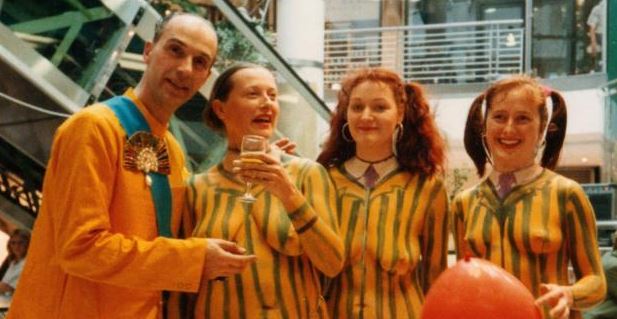TVC E. The Neo Naturists were a group of women who blazed a trail with their nude happenings. Lindsay Baker takes a look back
at their flamboyant performances.
“Stunned silence” was the audience reaction to a performance art piece by the Neo Naturists at London’s grand Royal Opera House, says artist Wilma Johnson, one of the group’s founder members. The naked cheer-leading routine with body paint and pom-poms left the entire venue in shock. The live-art group had been invited to perform at the fund-raising event by the ballet dancer and choreographer Michael Clark. It is Johnson’s favourite memory from the time. “When I was a kid I was chucked out of ballet school because I was really gawky,” she tells reporters, “so to silence the Royal Opera House was amazing.”
The Neo Naturists blazed a naked trail of disruption, confrontation, chaos and confusion through the 1980s London underground art scene, creating their nude happenings in front of bemused audiences at clubs, galleries and various public places, where the women often arrived unannounced, launching into their performance guerrilla style. Wild, non-conformist and provocative, the group was nevertheless largely forgotten, but is now being rediscovered, and has reformed for a retrospective of their work at the Studio Voltaire gallery in London. The exhibition incorporates film and photographs, as well as live performance – though not completely naked this time around.
By all accounts, the group’s performances were surreally humorous. Christine Binnie who, along with her sister Jennifer and Wilma Johnson, founded the group, recalls performing a live tableau of “fishermen and mermaids” outside the landmark Centrepoint building in central London. The performance attracted a lot of attention, she remembers, including that of the police: “We had a conversation with a policeman for about 10 minutes, but in the end he didn’t arrest us, just told us to put our coats on.” A law from the Victorian era still stands in England – it is only men, not women, who are prevented by law from exposing themselves in public.
A law from the Victorian era still stands in England – it is only men, not women, who are prevented by law from exposing themselves in public
The three women collaborated with and were part of a wider creative and social circle in London. Some of them went on to achieve considerable success – among them Michael Clark, artist Grayson Perry, singer Boy George, and film-makers Derek Jarman and John Maybury. Flamboyant would be an understatement for this loose collective of artists, art-school students, clubbers, performers and drag queens who were among the originators of the New Romantic movement, and also occasionally known as the Blitz kids.
In 1984, the group’s Swimming and Walking experiment took place outside the landmark Centrepoint in London (Credit: Courtesy of the Neo Naturists Archive)
As Jennifer Binnie puts it: “We were part of a mostly gay scene and the openness of that scene was what allowed us to do what we did. It was an expression of our own femininity.” Wearing nothing but body paint was also a way for the three women to keep up and to be ever more outrageous, shocking, out-there and radical. Grayson Perry particularly was a key collaborator at the time, and took part in many of the women’s performances, later describing the Neo Naturists as “true bohemians.”
Body talk
Certainly the trio embraced bohemian ideals from early on. For Christine, a visit to Germany in the late 1970s was the initial spark of inspiration. “The German punks were all sunbathing nude around the lake, whereas in Britain the punks were very pale, wore black and stayed indoors.” The Binnie sisters had been brought up by their artistic parents to believe in “being natural”. Freedom of expression was encouraged at home, with crafts and organic food a part of everyday life. “We’re all quite outdoorsy,” says Christine. The sisters’ childhood also involved membership of the Girl Guides, and their early love of camping subsequently found its way into one of their Neo-Naturist performances featuring a nude cooking ritual with a Calor-gas camping stove.
Wearing body paint and feather boas, the group poked fun at the more serious aspects of the era’s feminist movement (Credit: Courtesy of the Neo Naturists Archive)
Although always done with a sense of fun and humour, there was – and is – a serious point to the performances. “It was to do with freedom and showing female bodies the way they really were,” says Christine. “In a broad sense the three of us didn’t fit in because all the other girls on that scene were very heavily made up and dressed up, and the men were heavily stylised and aesthetically very beautiful too. Our style was more messy, more expressive. We weren’t conforming, and we weren’t titillating. It was about freedom and expression.” The group also confronted some of the more joyless aspects of the era’s feminist movement. “We questioned whether feminists were always empowering to women,” says Jennifer. “In the late 1970s and early ‘80s we didn’t fit into the feminist ideal – we wore feather boas and body paint, and we were funny.”
Christine Binnie, who co-founded the group, was body-painted and photographed by Wilma Johnson in the British Museum in 1982 (Credit: Courtesy of the Neo Naturists Archive)
The Binnie sisters have since worked as ceramicists, and Wilma Johnson is now a “practising surfer” who lives on a naturist beach in France and has written a book, Surf Mama, about her life. The three have remained friends through the decades. “The thing that was and is the most powerful about what we do is that we never do it alone,” says Christine. “We did it in a group which made us daring and we became this one powerful unit, so that’s part of the reason we came back together for this show. When you get to a certain age as a woman you start to feel invisible. People don’t even notice you.”
Naked ambitions
Needless to say, nakedness has always had a power to shock, titillate or make us laugh – as streakers at sporting and other public events have proved over the decades. Naturists and nudists meanwhile have traditionally been a figure of fun. But increasingly nakedness is being used in other contexts too. The artist Spencer Tunick creates extraordinary, living pieces of art using thousands of unclothed human models, most recently with more than 3,000 naked volunteers covered in blue body paint – for a large-scale art-work in Hull in anticipation of its year as the City of Culture in 2017.
Spencer Tunick creates living art works using a mass of unclothed human models, such as this one, using 3,000 blue-painted volunteers (Credit: PA)
Meanwhile, a recent TV programme and one-off social experiment on the UK’s Channel 4, Life Stripped Bare, explores how a group of people react to having all of their possessions, including clothes, removed for three weeks. And nudity or semi-nudity as a form of protest continues to be powerful – the recent World Naked Bike Ride was an international ‘clothing-optional’ protest about lack of road safety for cyclists.
We weren’t conforming, and we weren’t titillating. It was about freedom and expression – Christine Binnie
Advertisement
And of course there is Ukrainian activist group Femen and Russian punk protest group Pussy Riot, who have both made toplessness their trademark. Jessica Vaughan, the curator of the Neo-Naturist exhibition, argues that what the Binnies and Johnson were doing in the 1980s was ahead of its time and unfairly written out of history: “There is Femen and Pussy Riot, but the Neo Naturists were completely naked, they were ground-breaking,” she tells BBC Culture. “And they were under-represented in the 1980s, maybe because the scene they were involved in was dominated by men who were important figures. They worked alongside those figures but in an oppositional way – they were more messy, and more chaotic than the sometimes po-faced New Romantics.”
BBC






















